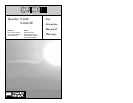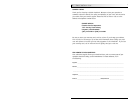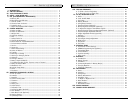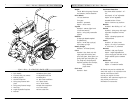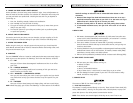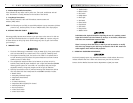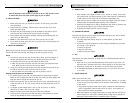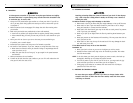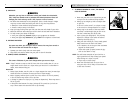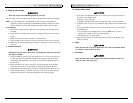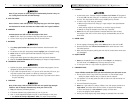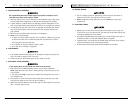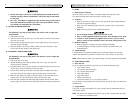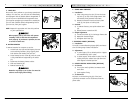
930477 Rev. A
V. EMI (Electromagnetic Interference)
9
Heed all warnings to reduce the risk of unintended brake release or chair
movement:
1. Beware of the danger from hand-held transceivers. Never turn on or use a
hand-held transceiver while power to your chair is on. Use extra care if you
believe that such a device may be in use near your chair.
2. Be aware of nearby radio or TV stations, and avoid coming close to them.
3. If unintended movement occurs, turn your chair off as soon as it is safe to
do so.
A.WHAT IS EMI?
1. EMI means: electromagnetic (EM) interference (I). EMI comes from radio wave
sources such as radio transmitters and transceivers. (A “transceiver” is a device
that both sends and receives radio wave signals).
2. There are a number of sources of intense EMI in your daily environment.
Some of these are obvious and easy to avoid. Others are not, and you may not
be able to avoid them.
3. Powered wheelchairs may be susceptible to electromagnetic interference (EMI)
emitted from sources such as radio stations, TV stations, amateur radio (HAM)
transmitters, two-way radios, and cellular phones.
4. EMI can also be produced by conducted sources or electo-static discharge (ESD).
B. WHAT EFFECT CAN EMI HAVE?
1. EMI can cause your chair, without warning, to:
• Release its brakes
• Move by itself
• Move in unintended directions
If any of these occurs, it could result in severe injury to you or others.
2. EMI can damage the control system of your chair. This could create a safety
hazard, and lead to costly repairs.
C. SOURCES OF EMI
The sources of EMI fall into three broad types:
1. Hand-Held Transceivers:
The antenna is usually mounted directly on the unit. These include: Citizens band (CB)
radios, “Walkie-talkies”, Security, fire and police radios, Cellular phones, Lap-top com-
puters with phone or fax, Other personal communication devices
NOTE– These devices can transmit signals while they are on, even if not in use.
IV. Notice– Read Before Use
930477 Rev. A
8
A. CHOOSE THE RIGHT CHAIR & SAFETY OPTIONS
Sunrise provides a choice of many power wheelchair styles, sizes and adjustments to
meet the needs of the rider. However, final selection of a wheelchair rests solely with
you and your health care professional. Choosing the best chair for you depends on
such things as:
1. Your size, disability, strength, balance and coordination.
2. Your intended use, and your level of activity.
3. The types of hazards you must overcome in daily use (in areas where you are
likely to use your chair).
4. The need for options for your safety and comfort (such as positioning belts
or special seat systems).
B. ADJUST CHAIR TO YOUR ABILITY
You need to work with your doctor, nurse or therapist, and your supplier, to fit this
chair and adjust the controller settings for your level of function and ability level.
C. REVIEW THIS MANUAL OFTEN
Before using this chair you, and each person who may assist you, should read this
entire Manual and make sure to follow all instructions. Review the warnings often, until
they are second nature to you.
D. WARNINGS
The word “WARNING” refers to a hazard or unsafe practice that may cause severe injury or
death to you or to other persons. The “Warnings” are in four main sections, as follows:
1. V. — EMI
Here you will learn about electomagnetic interference and how it can affect
your chair.
2. VI — GENERAL WARNINGS
Here you will find a safety checklist and a summary of risks you need to be
aware of before you ride this chair.
3. VII — WARNINGS — COMPONENTS & OPTIONS
Here you will learn about your chair. Consult your supplier and your health
care professional to help you choose the best set-up and options for your
safety.
4. XI — BATTERIES
Here you will learn about battery and charger safety, and how to avoid injury.
NOTE– Where they apply, you will also find
“
Warnings” in other sections of this Manual.



